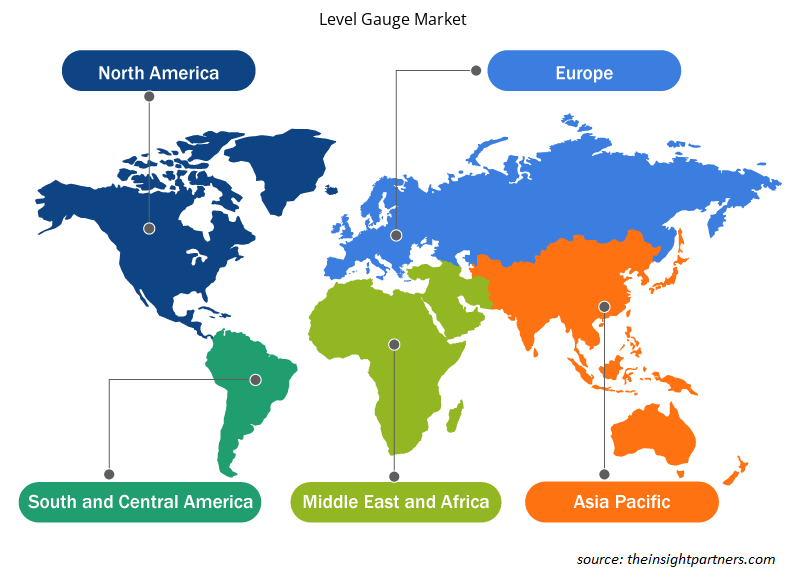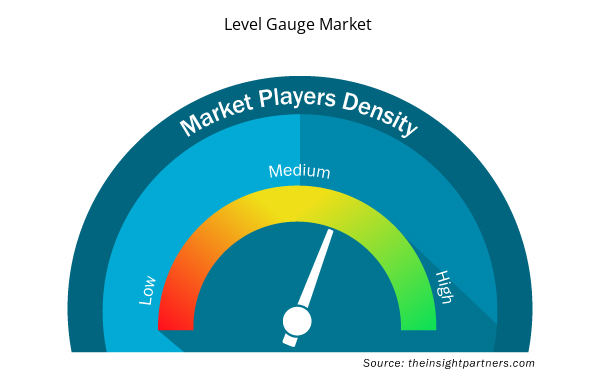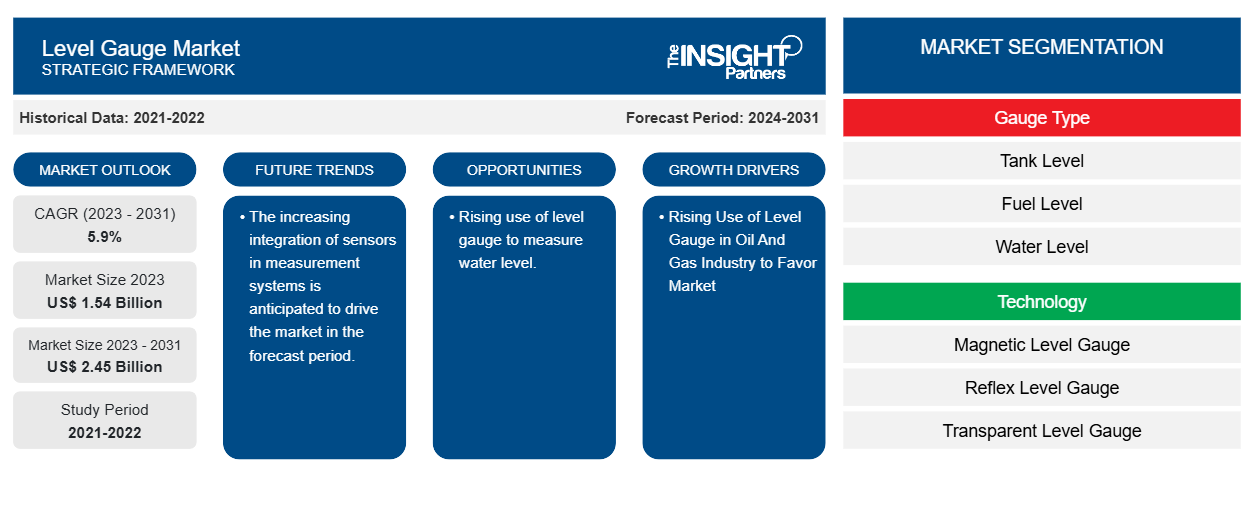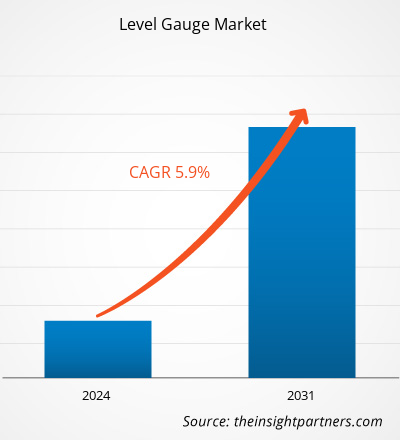Der Markt für Füllstandsmessgeräte soll von 1,54 Milliarden US-Dollar im Jahr 2023 auf 2,45 Milliarden US-Dollar im Jahr 2031 anwachsen. Der Markt soll zwischen 2023 und 2031 eine durchschnittliche jährliche Wachstumsrate (CAGR) von 5,90 % verzeichnen. Die zunehmende Verwendung von Füllstandsmessgeräten in der Öl- und Gasindustrie und der zunehmende Einsatz automatischer Tankmesssysteme dürften weiterhin wichtige Trends und Treiber des Marktes bleiben.
Marktanalyse für Füllstandsmessgeräte
Der Markt für Messgeräte verzeichnet weltweit ein deutliches Wachstum. Dieses Wachstum ist zurückzuführen aufdie zunehmende Verwendung von Füllstandsanzeigen in der Öl- und Gasindustrie und der zunehmende Einsatz automatischer Tankmesssysteme. Darüber hinaus wird erwartet, dass die zunehmende Verwendung von Füllstandsanzeigen zur Messung des Wasserstands und die Integration von Sensoren in Messsysteme das Marktwachstum in den kommenden Jahren vorantreiben werden.
Marktübersicht für Füllstandsmessgeräte
Füllstandsanzeiger sind Mess- und Sensorgeräte, die zur Überwachung des Flüssigkeitsstands in Tanks oder anderen Lagerbehältern verwendet werden. Diese Instrumente werden häufig in industriellen Prozessanwendungen verwendet, um Flüssigkeitsstände in Tanks, Fässern, Druckbehältern und anderen ähnlichen Anwendungen zu überwachen. Der Anzeiger besteht aus mehreren Teilen, darunter einem Kopf, einem Schwimmer, einem Maßband, einer unteren verankerten Halterung, Führungsdrähten, Winkelstücken, Ankern, einer Kupplung, Rohrhalterungen und Rohrleitungen.coupler, pipe support brackets, and pipework.
Passen Sie diesen Bericht Ihren Anforderungen an
Sie erhalten kostenlose Anpassungen an jedem Bericht, einschließlich Teilen dieses Berichts oder einer Analyse auf Länderebene, eines Excel-Datenpakets sowie tolle Angebote und Rabatte für Start-ups und Universitäten.
- Holen Sie sich die wichtigsten Markttrends aus diesem Bericht.Dieses KOSTENLOSE Beispiel umfasst eine Datenanalyse von Markttrends bis hin zu Schätzungen und Prognosen.
Markttreiber und Chancen für Füllstandsmessgeräte
Zunehmender Einsatz von Füllstandsanzeigern in der Öl- und Gasindustrie begünstigt den Markt.
Ölstandsanzeiger dienen zur Überwachung des Füllstands und zur Erkennung von Betriebszuständen. Sie ermöglichen eine schnelle, einfache visuelle Kontrolle und können neben Systemen mit Ölfüllung oder Ölfluss auch für andere Medien eingesetzt werden. Der optionale Reflektor ermöglicht eine einfache Ablesung des Füllstands, auch bei schlechter Sicht. Darüber hinaus können manuelle Tankmessverfahren für atmosphärische Tanks eingesetzt werden, die für Öl und Petrochemikalien geeignet sind , die bei Umgebungsbedingungen gelagert werden können. Traditionelle Methoden umfassen die Verwendung eines transparenten Füllstandsanzeigers und eines Maßbandes zur Berechnung des Füllstands. Beispielsweise kann die manuelle Methode zur Messung des Rohölstands in einem zylindrischen Tank mit Schwimmdach und eingebautem transparentem Anzeiger eingesetzt werden. Dies erhöht die Nachfrage und Verwendung von Füllstandsanzeigern in der Öl- und Gasindustrie.
Zunehmender Einsatz von Füllstandsanzeigern zur Messung des Wasserstands.
Füllstandsanzeiger bieten eine schnelle visuelle Anzeige des Wasserstands in einem Kanal, Gerinne oder Wehr. Obwohl man sich nicht ausschließlich auf sie verlassen sollte, wenn präzisere Füllstandsmessgeräte verfügbar sind, ermöglichen Füllstandsanzeiger dem Bediener, den relativen Wasserstand schnell zu messen und dann mit anderen Aufgaben fortzufahren. Darüber hinaus werden elektronische Wasserstandsanzeiger auf den Markt gebracht. Dabei handelt es sich um einen neuen Typ von Wasserstandsmesssensor, der aus einer Leiterplatte, einer gemeinsamen Elektrode, einer Detektionselektrode, Epoxidharz , einem Metallgehäuse, einem Kabel usw. besteht. Angesichts des hohen Bedarfs an Füllstandsanzeigern zur Messung des Wasserstands wird erwartet, dass der Markt in den kommenden Jahren wachsen wird.mwasurement of water level, the market is anticipated to grow in coming years.
Marktbericht zur Füllstandsanzeige – Segmentierungsanalyse
Wichtige Segmente, die zur Ableitung der Marktanalyse für Füllstandsmessgeräte beigetragen haben, sind Messgerätetyp, Technologie und Endbenutzer.
- Basierend auf dem Messgerätetyp ist der Markt für Füllstandsmessgeräte in Tankfüllstand, Kraftstofffüllstand, Wasserstand und mechanisches Niveau unterteilt. Es wird erwartet, dass das Tankfüllstandssegment im Prognosezeitraum einen erheblichen Marktanteil halten wird.
- Basierend auf der Technologie ist der Markt für Füllstandsanzeigen in magnetische Füllstandsanzeigen, Reflex-Füllstandsanzeigen, transparente Füllstandsanzeigen, tabellarische Füllstandsanzeigen und andere unterteilt. Es wird erwartet, dass das Segment der magnetischen Füllstandsanzeigen im Prognosezeitraum einen erheblichen Marktanteil halten wird.
- Nach Endverbraucher ist der Markt segmentiert in Öl und Gas, Lebensmittel und Getränke, Chemie und Petrochemie, Schifffahrt, Energie und Strom und andere. Es wird erwartet, dass Öl und Gas im Prognosezeitraum einen erheblichen Marktanteil halten werden.
Marktanteilsanalyse für Füllstandsmessgeräte nach geografischer Lage
Der geografische Umfang des Marktberichts für Füllstandsmessgeräte ist hauptsächlich in fünf Regionen unterteilt: Nordamerika, Asien-Pazifik, Europa, Naher Osten und Afrika sowie Süd- und Mittelamerika.
Nordamerika dominiert den Markt für Füllstandsmessgeräte. Der nordamerikanische Markt für Füllstandsmessgeräte ist in die USA, Kanada und Mexiko unterteilt. Der Markt in der Region wächst und das Wachstum ist auf die zunehmende Verwendung von Füllstandsmessgeräten in der Öl- und Gasindustrie und den zunehmenden Einsatz automatischer Tankmesssysteme zurückzuführen. Darüber hinaus zwingt eine starke Betonung von Forschung und Entwicklung in den entwickelten Volkswirtschaften der USA und Kanadas die nordamerikanischen Akteure dazu, technologisch fortschrittliche Lösungen auf den Markt zu bringen. Darüber hinaus gibt es in den USA eine große Anzahl von Akteuren auf dem Markt für Füllstandsmessgeräte, die sich zunehmend auf die Entwicklung innovativer Lösungen konzentrieren. All diese Faktoren tragen zum Wachstum des Marktes für Füllstandsmessgeräte in der Region bei.
Regionale Einblicke in den Markt für Füllstandsmessgeräte
Die regionalen Trends und Faktoren, die den Markt für Füllstandsmessgeräte im Prognosezeitraum beeinflussen, wurden von den Analysten von Insight Partners ausführlich erläutert. In diesem Abschnitt werden auch die Marktsegmente und die Geografie von Füllstandsmessgeräten in Nordamerika, Europa, im asiatisch-pazifischen Raum, im Nahen Osten und Afrika sowie in Süd- und Mittelamerika erörtert.

- Erhalten Sie regionale Daten zum Markt für Füllstandsmessgeräte
Umfang des Marktberichts über Füllstandsanzeiger
| Berichtsattribut | Details |
|---|---|
| Marktgröße im Jahr 2023 | 1,54 Milliarden US-Dollar |
| Marktgröße bis 2031 | 2,45 Milliarden US-Dollar |
| Globale CAGR (2023 - 2031) | 5,9 % |
| Historische Daten | 2021-2022 |
| Prognosezeitraum | 2024–2031 |
| Abgedeckte Segmente | Nach Messgerätetyp
|
| Abgedeckte Regionen und Länder | Nordamerika
|
| Marktführer und wichtige Unternehmensprofile |
|
Marktteilnehmerdichte: Der Einfluss auf die Geschäftsdynamik
Der Markt für Füllstandsmessgeräte wächst rasant, angetrieben durch die steigende Nachfrage der Endnutzer aufgrund von Faktoren wie sich entwickelnden Verbraucherpräferenzen, technologischen Fortschritten und einem größeren Bewusstsein für die Vorteile des Produkts. Mit steigender Nachfrage erweitern Unternehmen ihr Angebot, entwickeln Innovationen, um die Bedürfnisse der Verbraucher zu erfüllen, und nutzen neue Trends, was das Marktwachstum weiter ankurbelt.
Die Marktteilnehmerdichte bezieht sich auf die Verteilung von Firmen oder Unternehmen, die in einem bestimmten Markt oder einer bestimmten Branche tätig sind. Sie gibt an, wie viele Wettbewerber (Marktteilnehmer) in einem bestimmten Marktraum im Verhältnis zu seiner Größe oder seinem gesamten Marktwert präsent sind.
Die wichtigsten auf dem Markt für Füllstandsmessgeräte tätigen Unternehmen sind:
- ABB Ltd
- Barksdale Inc
- Ayvaz
- BinMaster
- JBJ Techniques Ltd.
- Jogler, LLC
Haftungsausschluss : Die oben aufgeführten Unternehmen sind nicht in einer bestimmten Reihenfolge aufgeführt.

- Überblick über die wichtigsten Akteure auf dem Markt für Füllstandsmessgeräte
Neuigkeiten und aktuelle Entwicklungen zum Füllstandsmessgerätemarkt
Der Markt für Füllstandsmessgeräte wird durch die Erhebung qualitativer und quantitativer Daten nach Primär- und Sekundärforschung bewertet, die wichtige Unternehmensveröffentlichungen, Verbandsdaten und Datenbanken umfasst. Nachfolgend sind einige der Entwicklungen auf dem Markt für Füllstandsmessgeräte aufgeführt:
- Mit der Einführung des BM26A-8000 schloss KROHNE 2023 die Markteinführung der neuen BM26A-Serie magnetischer Füllstandsanzeiger (MLI) ab. Die Geräte ersetzen die vorherige Generation und sind auf die spezifischen Anforderungen der Industrie zugeschnitten. (Quelle: KROHNE Messtechnik GmbH Unternehmenswebsite Juni 2023)
Marktbericht zu Füllstandsanzeigern – Umfang und Ergebnisse
Der Bericht „Marktgröße und Prognose für Füllstandsmessgeräte (2021–2031)“ bietet eine detaillierte Analyse des Marktes, die die folgenden Bereiche abdeckt:
- Marktgröße und Prognose für Füllstandsmessgeräte auf globaler, regionaler und Länderebene für alle wichtigen Marktsegmente, die im Rahmen des Berichts abgedeckt sind
- Markttrends und Marktdynamiken wie Treiber, Beschränkungen und wichtige Chancen aufzeigen
- Detaillierte PEST/Porters Five Forces- und SWOT-Analyse
- Marktanalyse für Füllstandsanzeigen, die wichtige Markttrends, globale und regionale Rahmenbedingungen, wichtige Akteure, Vorschriften und aktuelle Marktentwicklungen umfasst
- Branchenlandschaft und Wettbewerbsanalyse, die die Marktkonzentration, Heatmap-Analyse, prominente Akteure und aktuelle Entwicklungen auf dem Markt für Füllstandsmessgeräte umfasst
- Detaillierte Firmenprofile
- Historische Analyse (2 Jahre), Basisjahr, Prognose (7 Jahre) mit CAGR
- PEST- und SWOT-Analyse
- Marktgröße Wert/Volumen – Global, Regional, Land
- Branche und Wettbewerbsumfeld
- Excel-Datensatz



Report Coverage
Revenue forecast, Company Analysis, Industry landscape, Growth factors, and Trends

Segment Covered
This text is related
to segments covered.

Regional Scope
North America, Europe, Asia Pacific, Middle East & Africa, South & Central America

Country Scope
This text is related
to country scope.
Häufig gestellte Fragen
North America is anticipated to dominate the level gauge market in 2023.
The increasing use of level gauges in the oil & gas industry and rising deployment of automatic tank gauge systems are some of the factors driving the level gauge market.
The increasing integration of sensors in measurement systems is anticipated to drive the market in the forecast period.
The key players holding majority shares in the global level gauge market are ABB Ltd, Barksdale Inc, Ayvaz, BinMaster, JBJ Techniques Ltd., Jogler, LLC, KOBOLD Messring GmbH, KROHNE Messtechnik GmbH, Krueger Sentry Gauge Co., SensorsOne Ltd.
The global level gauge market is expected to reach US$ 2.45 billion by 2031.
The expected CAGR of the level gauge market is 5.90%.
Trends and growth analysis reports related to Electronics and Semiconductor : READ MORE..
The Insight Partners performs research in 4 major stages: Data Collection & Secondary Research, Primary Research, Data Analysis and Data Triangulation & Final Review.
- Data Collection and Secondary Research:
As a market research and consulting firm operating from a decade, we have published and advised several client across the globe. First step for any study will start with an assessment of currently available data and insights from existing reports. Further, historical and current market information is collected from Investor Presentations, Annual Reports, SEC Filings, etc., and other information related to company’s performance and market positioning are gathered from Paid Databases (Factiva, Hoovers, and Reuters) and various other publications available in public domain.
Several associations trade associates, technical forums, institutes, societies and organization are accessed to gain technical as well as market related insights through their publications such as research papers, blogs and press releases related to the studies are referred to get cues about the market. Further, white papers, journals, magazines, and other news articles published in last 3 years are scrutinized and analyzed to understand the current market trends.
- Primary Research:
The primarily interview analysis comprise of data obtained from industry participants interview and answers to survey questions gathered by in-house primary team.
For primary research, interviews are conducted with industry experts/CEOs/Marketing Managers/VPs/Subject Matter Experts from both demand and supply side to get a 360-degree view of the market. The primary team conducts several interviews based on the complexity of the markets to understand the various market trends and dynamics which makes research more credible and precise.
A typical research interview fulfils the following functions:
- Provides first-hand information on the market size, market trends, growth trends, competitive landscape, and outlook
- Validates and strengthens in-house secondary research findings
- Develops the analysis team’s expertise and market understanding
Primary research involves email interactions and telephone interviews for each market, category, segment, and sub-segment across geographies. The participants who typically take part in such a process include, but are not limited to:
- Industry participants: VPs, business development managers, market intelligence managers and national sales managers
- Outside experts: Valuation experts, research analysts and key opinion leaders specializing in the electronics and semiconductor industry.
Below is the breakup of our primary respondents by company, designation, and region:

Once we receive the confirmation from primary research sources or primary respondents, we finalize the base year market estimation and forecast the data as per the macroeconomic and microeconomic factors assessed during data collection.
- Data Analysis:
Once data is validated through both secondary as well as primary respondents, we finalize the market estimations by hypothesis formulation and factor analysis at regional and country level.
- Macro-Economic Factor Analysis:
We analyse macroeconomic indicators such the gross domestic product (GDP), increase in the demand for goods and services across industries, technological advancement, regional economic growth, governmental policies, the influence of COVID-19, PEST analysis, and other aspects. This analysis aids in setting benchmarks for various nations/regions and approximating market splits. Additionally, the general trend of the aforementioned components aid in determining the market's development possibilities.
- Country Level Data:
Various factors that are especially aligned to the country are taken into account to determine the market size for a certain area and country, including the presence of vendors, such as headquarters and offices, the country's GDP, demand patterns, and industry growth. To comprehend the market dynamics for the nation, a number of growth variables, inhibitors, application areas, and current market trends are researched. The aforementioned elements aid in determining the country's overall market's growth potential.
- Company Profile:
The “Table of Contents” is formulated by listing and analyzing more than 25 - 30 companies operating in the market ecosystem across geographies. However, we profile only 10 companies as a standard practice in our syndicate reports. These 10 companies comprise leading, emerging, and regional players. Nonetheless, our analysis is not restricted to the 10 listed companies, we also analyze other companies present in the market to develop a holistic view and understand the prevailing trends. The “Company Profiles” section in the report covers key facts, business description, products & services, financial information, SWOT analysis, and key developments. The financial information presented is extracted from the annual reports and official documents of the publicly listed companies. Upon collecting the information for the sections of respective companies, we verify them via various primary sources and then compile the data in respective company profiles. The company level information helps us in deriving the base number as well as in forecasting the market size.
- Developing Base Number:
Aggregation of sales statistics (2020-2022) and macro-economic factor, and other secondary and primary research insights are utilized to arrive at base number and related market shares for 2022. The data gaps are identified in this step and relevant market data is analyzed, collected from paid primary interviews or databases. On finalizing the base year market size, forecasts are developed on the basis of macro-economic, industry and market growth factors and company level analysis.
- Data Triangulation and Final Review:
The market findings and base year market size calculations are validated from supply as well as demand side. Demand side validations are based on macro-economic factor analysis and benchmarks for respective regions and countries. In case of supply side validations, revenues of major companies are estimated (in case not available) based on industry benchmark, approximate number of employees, product portfolio, and primary interviews revenues are gathered. Further revenue from target product/service segment is assessed to avoid overshooting of market statistics. In case of heavy deviations between supply and demand side values, all thes steps are repeated to achieve synchronization.
We follow an iterative model, wherein we share our research findings with Subject Matter Experts (SME’s) and Key Opinion Leaders (KOLs) until consensus view of the market is not formulated – this model negates any drastic deviation in the opinions of experts. Only validated and universally acceptable research findings are quoted in our reports.
We have important check points that we use to validate our research findings – which we call – data triangulation, where we validate the information, we generate from secondary sources with primary interviews and then we re-validate with our internal data bases and Subject matter experts. This comprehensive model enables us to deliver high quality, reliable data in shortest possible time.


 Holen Sie sich ein kostenloses Muster für diesen Bericht
Holen Sie sich ein kostenloses Muster für diesen Bericht